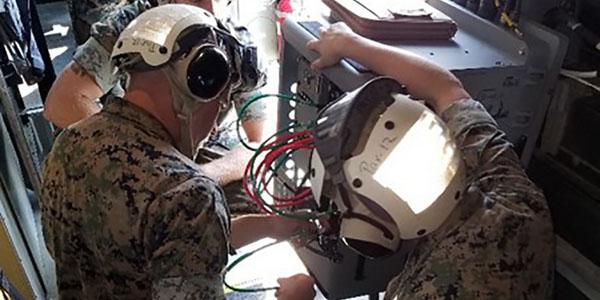Marine Corps Tactical Network Moves to the Air
The effort of the U.S. Marine Corps Systems Command in bringing the networking on-the-move platform to more aircraft is coming to fruition. The service announced on June 28 that it had placed a new iteration of tactical network family of systems known as the NOTM onto the MV-22 Osprey tiltrotor aircraft.
The new NOTM-Airborne Increment II System can provide communications access for up to five users, including access to networks, voice, email, video and texting capabilities while airborne, command officials noted.
Ground forces have been using the first version of the system—called NOTM-Airborne Increment I (also known as the Hatch-Mounted Satellite Communication Antenna System)—since 2015, when it was fielded to Special Purpose Marine Air-Ground Task Forces, command officials said. NOTM-Airborne Increment I provided warfighters real-time access to networks during airborne operations aboard KC-130 aircraft. “The capability enabled mission commanders to conduct en route planning and execution across several types of missions,” the command officials explained.
To expand the capability to other aircraft, officials from the Marine Corps Systems Command built Increment II. The command worked in conjunction with the U.S. Navy’s Naval Air Systems Command (NAVAIR) to modify the Osprey for installation and operation of Increment II. Modifications to the Osprey included replacing the rear overhead hatch, installing a SATCOM radome and installing system interface cables, the officials said.
The command fielded the first of the systems to the 22nd Marine Expeditionary Unit (MEU) this month, the officials reported.
"It can take hours to fly to a location to complete a mission, and during that time, the situation on the ground can change significantly," said Chris Wagner, NOTM lead engineer, Marine Corps Systems Command’s (MCSC’s) Command Element Systems. "The NOTM capability provides Marines with real time command, control and collaborative mission planning while airborne."
Increment II will provide accurate and up-to-date en route information, "which is critical for mission accomplishment and force protection," added Lt. Col. Devin Licklider, USMC, program manager of Command and Control Systems, Portfolio Management (PfM) Command Element Systems, MCSC. If the situation on the ground changes, we can get updates to the common operating picture, from reconnaissance assets to the commander enabling mission changes while en route."





Comments